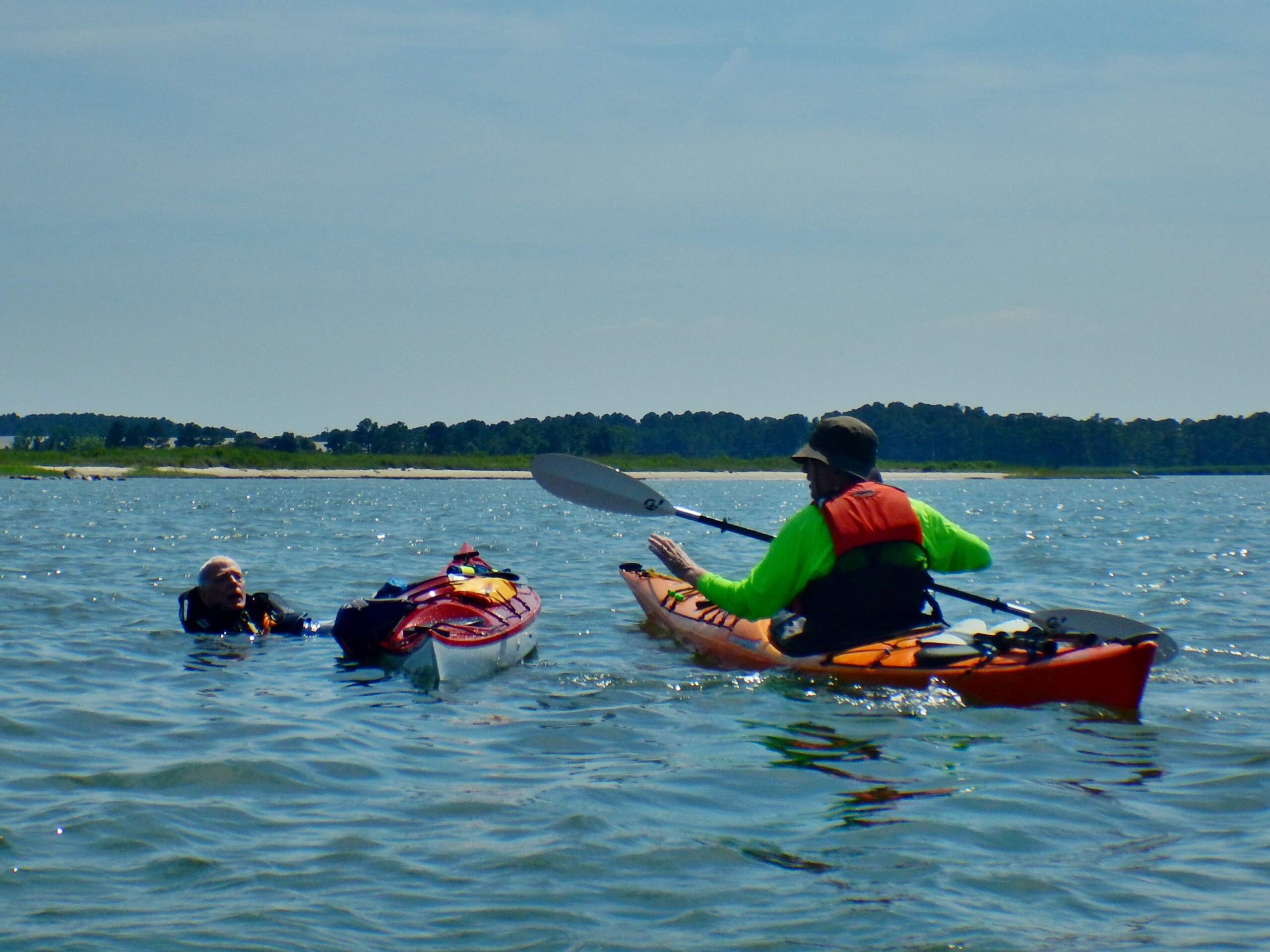Coordinator’s Column – Managing Fear
I first started sea kayaking on the west coast in the San Francisco Bay area. I took my first class, did my first wet exit, and bought my first boat… a Current Designs Andromeda, not exactly a beginner’s boat. I was all in to the sport. I joined Bay Area Sea Kayakers (BASK) and started gong on paddles in the open bay. Of course, I was scared a lot. I constantly worried about my skills, my strength, capsizing, and weather. Would I be so slow that I’d be left behind in the middle of the Bay? Would I have fun or would it be horrible?
Fear is a normal reaction that warns our bodies to be careful. There are several types of fear. A phobia is an irrational fear focused on something specific. You probably would not be a paddler if you had a phobia about being on or in the water. Anxiety is a type of fear, dealing more with worry about the future, rather than fearing something that is present. We see a lot of anxiety during SK102 when new paddlers are getting ready to do their first wet exit. True fear is an appropriate response to something that is actually threatening. When you are in a potentially dangerous situation, realistically appraise your skills vs. the demands of the environment. Maybe you don’t need to go there. This is not giving in to your fear, it is an appropriate response.
How can we recognize the anxious or fearful paddler? I’ve seen anxious paddlers who paddle fast out in front of the group, never looking back, possibly unaware that they’re scared, and afraid to even turn around. For some people it’s hard to admit that they’re scared. Fearful paddlers may become tense. They have what we call a white-knuckle grip on the paddle. Their boats may appear wobbly because they are so tense. Frequently, the cause of anxiety is fear of the unknown, or what might happen as opposed to what is going to happen.
 When kayaking, we have several common causes of fear and anxiety. Many kayakers have a fear of capsizing, the fear of being trapped or stuck is under water is a very real core fear. Any time your boat is in rough water and you worry about a capsize, this fear may be triggered. The best way to overcome this type of fear is to learn to relax. Easier said than done. Learn to do a wet exit in a safe environment (SK102 or Fall out of your Boat Day is a perfect opportunity). It takes time to build your skill level gradually. Learn more about weather, waves, and local conditions. Build your kayaking skills. Start with your comfort level; push it bit by bit. It helps to work with an instructor, coach, or mentor.
When kayaking, we have several common causes of fear and anxiety. Many kayakers have a fear of capsizing, the fear of being trapped or stuck is under water is a very real core fear. Any time your boat is in rough water and you worry about a capsize, this fear may be triggered. The best way to overcome this type of fear is to learn to relax. Easier said than done. Learn to do a wet exit in a safe environment (SK102 or Fall out of your Boat Day is a perfect opportunity). It takes time to build your skill level gradually. Learn more about weather, waves, and local conditions. Build your kayaking skills. Start with your comfort level; push it bit by bit. It helps to work with an instructor, coach, or mentor.
Developing comfort in conditions that once caused anxiety doesn’t happen overnight. Don’t expect one class or session to fix everything. As you push out of your comfort zone focus on making yourself relax and breath. When I was learning to become comfortable in rough water it took several years, not days or weeks to gradually build my comfort level in rougher and rougher water. Practice is essential. If you don’t push the limits of your comfort zone, it can contract rather than expand. Fear isn’t always about big waves, wind, or surf. It is any condition where you feel uncomfortable.
Breathing is more important than you think. Usually, anxiety begins with short breaths. The short breaths cause a number of negative reactions in your body which quickly become an anxiety attack. The key to overcoming those fast outbreaks of anxiety is to control your breathing. When I notice a paddler becoming anxious, I frequently just start a light conversation. That distraction can get the paddler to think about something other than the next wave that might knock them over.
Another common fear is fear of failure. The fear of failing is something most people struggle with at some point in their lives. It can show up as perfectionism, performance anxiety, or even a pattern of playing it safe and avoiding the spotlight. This type of fear may stop you from exploring more challenging environments, even when you have the necessary skills.
How do you manage fear when a challenging situation presents itself? Her are some techniques that may help.
§ Remember when were successful in a similar situation.
§ Visualize doing it successfully
§ Remember your training.
§ Think big, engage your core muscles, keep paddling.
§ I talk to my kayak; The boat wants to be upright with me in it.
 A common scenario involving fear occurs when you are paddling in relatively calm water, but as you come out of the shelter of shore, the wind picks up, the water becomes more confused, there is rebound of waves from a sea wall. The water looks much rougher than what you normally paddle. Your initial reaction is fear. You become tense, breathing becomes shallower and sometimes you even hold your breath. You hold the paddle tighter. Your smooth forward stroke becomes short and choppy. You stop paddling and start to brace. You are afraid that you will capsize and the water is cold and wet.
A common scenario involving fear occurs when you are paddling in relatively calm water, but as you come out of the shelter of shore, the wind picks up, the water becomes more confused, there is rebound of waves from a sea wall. The water looks much rougher than what you normally paddle. Your initial reaction is fear. You become tense, breathing becomes shallower and sometimes you even hold your breath. You hold the paddle tighter. Your smooth forward stroke becomes short and choppy. You stop paddling and start to brace. You are afraid that you will capsize and the water is cold and wet.
To overcome this fear, remember your training. Sit up straight, try to consciously relax, and let the boat move with the water. Remember your good powerful forward stroke. Powerful strokes moving the boat through the water provides more stability than sitting still. As you feel the boat stabilize and you successfully paddle through the confused area into calmer water you relax and continue to enjoy the paddle. The next time you encounter the same situation remember the feeling of successfully paddling through similar conditions on a previous paddle. Eventually you will no longer fear these conditions, your comfort zone has expanded.
If you are still afraid, is what you want to do realistic? It’s OK to admit something is scary. Do you have the capacity to go on? Can you stop and talk about it? Can you avoid the situation, take a different route, or just go back? You don’t have to and in reality, shouldn’t do everything that scares you. In fact, sometimes people are not fearful when they should be.
When dealing with fear, we need to understand risk and the difference between perceived danger and real danger. A moderate area of rough water near an inlet with an on-shore wind and incoming tide is not a real danger. You might capsize but you know how to do a wet exit safely, the incoming tide will carry you to a safe area where you can get back in your boat with the assistance of someone in your group. As long as you are dressed for the water and have the basic skills, you can safely push your comfort zone. The same conditions with an outgoing tide and off shore wind presents more of a real danger. A capsize may result in being carried out into an inlet into more dangerous waters. Lightning is an absolute real danger. You need to get off the water.
The most important thing is to acknowledge when you get scared, and figure out what it is that’s scaring you. As sea kayakers we need to examine and manage our fear because fear can incapacitate us, and it keeps us from having fun. Being thrilled is fun, but being scared is not. Fear is physical and can impede skills and judgment. Learn to help others and yourself deal with fear and your paddling trips will be more rewarding. The awareness of fear will help you experience the pleasure of sea kayaking and of just being alive.
 So, keep paddling, safely expand your comfort zone as far as you choose. Not everyone is expected to be a rough water paddler, and some can have fun playing in those conditions. It’s all about your personal choices.
So, keep paddling, safely expand your comfort zone as far as you choose. Not everyone is expected to be a rough water paddler, and some can have fun playing in those conditions. It’s all about your personal choices.
Paula Hubbard
CPA Coordinator
Share This